
(Note: I haven’t finished putting in some of the links I mention but know that some of you want this in time to make Christmas gifts)
This is a free pattern for a scarf made up of rectangles joined together and surrounded by a picot-edged border, a fun accessory for anyone who loves Hello Kitty. Each rectangle features either a cute kitty face or a traditional granny square (modified slightly to make it oblong).
It is very long. I’ve tried to bold the most information so that you have an idea of how it’s put together, but of course, at some point, I think you should read it all! At the end, I’ve also included links for a pdf of the pattern; it is shorter than these directions here, has fewer photos, more condensed instructions, and fewer explanations.
I have already been informed of some errors (wrong stitch total, missing stitches, etc) and have fixed those. I have also tried to fix some spots that others have found confusing. But the pattern probably still contains some errors and confusions; please let me know if you find them.
Also, I did not think of this idea/design/motif myself; rather, I saw it as a pattern on Ravelry (which in turn was an adaptation, I believe, from a pattern in a Japanese crochet book), then I also found other versions online. However, when I tried them, I didn’t like the shape of the resulting kitty face nor the fact that the ears were added separately. I also didn’t like how dense the final round around the kitty face was; it didn’t look like a granny square round. So I made up my own pattern, this one here, but it’s based on someone else’s design.
OK, then. Here goes…
Materials:
5.00mm/US H(8) crochet hook
6.00mm/US J(10) crochet hook
Yarn needle
Optional but highly recommended: Stitch markers
(Alice at futuregirl.com has a tutorial on how to make stitch markers out of paper clips. Quick, easy, and cheap!)
Worsted weight yarn for:
 face (white)
face (white) - outline (your choice; I used grey; red is also very nice)
- background (your choice; I used bright pink for one scarf, purple for another, and aqua for a third)
- eyes and whiskers (black)
- nose (yellow, or light pink if you don’t care about being “authentic”)
- flower or bow (your choice; I used yellow)
- granny square colors 1, 2, 3 (I used white, grey, and my background color)
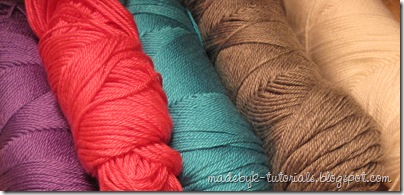
(Model made with Caron Simply Soft)
Gauge:
4 sc = 1” (2.5 cm), 4-5 rows of sc = 1” (2.5 cm)
(if gauge even matters here)
Finished Size:
Width: about 7” (18 cm)
Length: depends on number of squares you use
Each granny square*: 5” x 6” (13 cm x 16 cm)
Face appliqué only: 3¼” x 4” (8 cm x 11 cm)
*The finished “square” is actually not. But who’s ever heard of a Granny Rectangle? So I’m just going to call them as squares throughout.
Abbreviations:
Most of these abbreviations are standard. The ones I made up are shown in bold.
| beg | = | beginning |
| BLO | = | back loop only
(instead of inserting hook under both loops of a stitch, insert hook under the back loop only; more, with photos, here) |
| ch | = | chain
(yarn over, pull up a loop through loop on hook) |
| dc | = | double crochet
(equivalent to UK treble crochet; yarn over, insert hook in next st, yarn over, pull up a loop, {yarn over, pull through two loops} twice) |
| hdc | = | half double crochet
(equivalent to UK half treble crochet; yarn over, insert hook in next st, yarn over, pull through all three loops on hook) |
| R | = | row or round |
| sc | = | single crochet
(equivalent to UK double crochet; insert hook in next st, yarn over, pull up a loop, yarn over, and pull through both loops on hook) |
| sc x N | = | single crochet in next N stitches, where N is some number |
| sl st | = | slip stitch
(insert hook in next st, yarn over, and pull through work as well as remaining loop(s) on hook) |
| sp | = | space |
| st(s) | = | stitch(es) |
| tc | = | treble (or triple) crochet
(equivalent to UK double treble; yarn over twice, insert hook in next st, yarn over, pull up a loop, {yarn over, pull though two loops} three times) |
| V | = | 2 single crochets in next stitch |
| V x N | = | 2 single crochets each in next N stitches, where N is some number |
| W | = | 3 single crochets in next stitch |
| yo | = | yarn over |
Special Stitches & Techniques:
DOUBLE = skip 4 st, 3 dc in next st (for face square)
or skip 3 dc st from prev rnd , 3 dc in next ch sp (for granny square)
EAR = sl st in next st, hdc in next st, ch 1, dc in same st as hdc, ch 1, tc in next st, ch 1, dc in next st, ch 1, hdc in same st as dc, sl st in next st
fsc = foundation single crochet. A year ago, I’d never heard of this stitch. Now it’s my favorite way to start. In this case of only 4 starting stitches, it doesn’t make that big a difference, so if you’d rather not learn it right now, I’ve provided an alternate method. But on pieces that start with longer chains, I find fsc so much easier, faster, nicer. Essentially, each fsc stitch is made of up a “chain” part and a “stitch” part. So you get your starting chain and your first row at the same time! Do an online search for “foundation single crochet” for more info, tutorials, videos… Here’s a great fsc tutorial with photos to get you started, from Alice at futuregirl.com
magic ring = an alternate beginning method when crocheting in the round, which allows one to avoid having a hole left at the center start. Essentially, instead of slip stitching a short chain to make a ring, you make a ring by looping the yarn around your fingers. Need some photos and more instructions? Here’s a great magic ring tutorial by June that includes a comparison picture (“normal” way with hole and “magic ring” way without hole), but her tutorial uses single crochet around the ring. Here’s another great magic ring tutorial by Donna which doesn’t have the comparison picture but does use double crochet which is what we need for the granny squares.
JSS = joining slip stitch. Another great technique, this is for joining granny squares as you go instead of stitching them all together at the end. I first saw this technique beautifully explained by Lucy at attic24. Essentially, you substitute a slip stitch for a chain stitch along sides you want to join, inserting your hook into the corresponding chain space of another square before completing the slip stitch. For the scarf, always join along the longer edge of the square. I’ve given detailed steps with photos in the Join As You Go section below.
picot = sc, ch3, sl st in 1st ch or sl st, ch 3, sl st in same st or whatever picot stitch you prefer
TRIPLE = skip 4 st, 3 tc in next st (for face square)
or skip 3 tc st from prev rnd , 3 tc in next ch sp (for granny square)
Setup & Planning
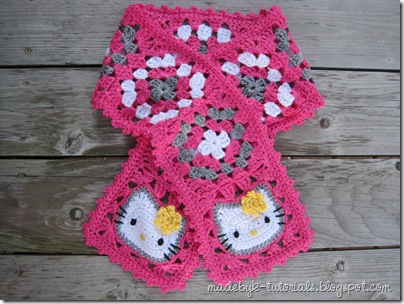
This pattern is for a crocheted Hello Kitty Granny Square Scarf as shown above – a scarf with a Hello Kitty Granny Square at each end and seven regular granny squares in between (four with white at the center, three with grey). The scarf, intended for a 5-year-old girl, ended up about 45” long.
If you want to make it longer or change the pattern of the squares, here’s what I can suggest: Figure out how many squares you need by dividing your desired finished scarf length by 5” (12.75cm) and rounding to nearest whole number. Decide how many face squares you want to include, then figure how many granny squares you need to reach your total. Also, decide on the pattern or order in which to attach the squares.
Note: I made this scarf by joining the squares as I crocheted the last round of each square and that’s how I’ll describe the steps. First I’ll give the patterns for how to make the kitty faces and the first three rounds of the granny squares. Then I’ll give the stitch instructions for completing the kitty face squares and granny squares, joining them to previous squares as you go. (If you’d rather, you can complete each square as if it’s the first, then whipstitch or crochet them together at the end.) Next, I’ll give the instructions for the scarf border. And finally, I’ll give the instructions for adding the embroidered facial features and crocheting the ear accessory.
Kitty Faces
You’ll need to make one for each Hello Kitty Granny Square in your scarf. I’m making two per scarf.

I used my own shorthand for writing these directions. Example: R5: ch1, turn, sc x 2, V, sc x 6, V, sc… means that after you chain 1 and turn, you make 1 single crochet in the next 2 stitches (sc x 2), then make 2 single crochets in the next stitch (V), followed by one single crochet in the next 6 stitches (sc x 6), and again 2 sc in the next stitch(V), followed by 1 single crochet in the next stitch (sc), etc.
If you would prefer to use conventional crochet pattern terminology, here’s the pattern using abbreviations and here’s the pattern using full text.
Notes:
- Stitch count is shown at end of each line. Ex. “—18 sts.”
- Do not count the ch1 at the start of each round as a stitch. Do count the sl st at the end of each row as a stitch. (So, the sl st at end of current round becomes the “first stitch” to use in next round.)
Start with face color yarn(white) and 5.00mm hook:
R1: 4 fsc (or alternate method: ch5, sc in 2nd ch from hook, sc in remaining 3 ch) —4 sts.
R2: ch1, turn, V (in top of fsc closest to hook), sc in next 2 sts, V (in top of last fsc), V (in bottom of last fsc), 3 sc in bottoms of next 3 fsc, sl st to 1st sc of current round —12 sts.
R3: ch1, turn, sc, V, sc x 2, V x 3, sc x 4, V, sl st to 1st sc of current round —18 sts.
R4: ch1, turn, sc, V, sc x 6, V x 3, sc x 6, V, sl st to 1st sc of current round —24 sts.
R5: ch1, turn, sc x 2, V, sc x 6, V, sc, V, sc, V, sc x 8, V, sc, sl st to 1st sc of current round —30 sts.
R6: ch1, turn, sc x 3, V, sc x 8, V, sc, V, sc x 2, V, sc x 10, V, sc, sl st to 1st sc of current round —36 sts.
R7: ch1, turn, sc x 3, V, sc x 10, V, sc x 2, V, sc x 2, ear, sc x 4, ear, sc x 2, switch yarn to outline color (grey), sl st to 1st sc of current round (pulling the new color through) —52 st.
Continuing with outline color (grey):
R8: ch1, turn, sc x 3, skip sl st, sc x 4, W (mark middle/2nd stitch), sc x 4, skip sl st, sc x 4, skip sl st, sc x 4, W, sc x 4, skip sl st, sc x 2, V, sc x 2, V, sc x 14, V, sc x 2, sl st to 1st sc of current round; bind off —56 st.
Granny Square Centers
Time to make the other squares for the scarf, the ones that looks like regular Granny Squares. Only thing: they’ve been altered slightly to make them into rectangles instead of squares so that they’ll match the finished shape of the Hello Kitty Granny Squares.
Make as many as you need for your scarf. I’m making at least 7 per scarf, 4 starting with white and 3 with grey.
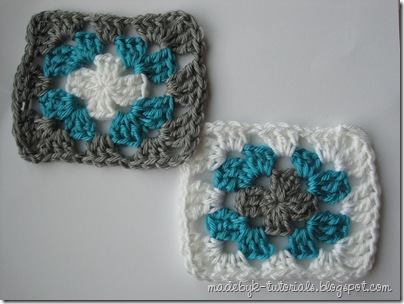
In a nutshell, along two sides opposite each other, I substituted triple crochets for the double crochets (see photo below). So if you already know how to granny square, grab a 6.00mm hook and have at it, making the necessary stitch changes on two sides.
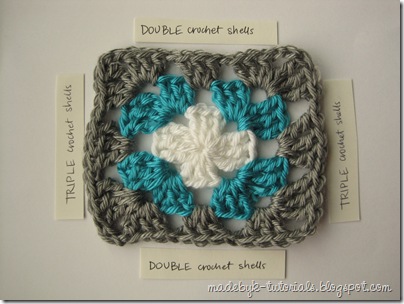
Otherwise, here’s the pattern for the slightly altered granny squares. By the way, here’s a video by Beth showing how to change color and draw in your starting tail on granny squares and here’s a video by Anne showing how to weave in your ending tails on granny squares.
Start with Color 1 (white/grey) yarn and 6.00mm hook:
Start: use a magic ring (or alternate method: ch 6, or 5 or 4…, sl st to starting ch to join into a ring).
R1: ch 3 (counts as 1 dc st, here and throughout), 2 dc in ring, ch 2, 3 tc in ring, ch 2, 3 dc in ring, ch2, 3 tc in ring, ch 2 (this makes the 4th corner), sl st to top chain of beg ch-3. Bind off.
Switch to Color 2 (background color: pink, purple, aqua) yarn.
R2: Insert hook into the 4th corner ch-2 sp, yo (with new color) and pull a loop through, ch3, 2 dc in same sp, {ch1, DOUBLE,} ch 2, 3 tc in same sp, {ch 1, TRIPLE,} ch2, 3 dc in same sp, {ch 1, DOUBLE,} ch 2, 3 tc in same sp, {ch 1, TRIPLE,} ch2, sl st to top chain of beg ch-3. Bind off.
Switch to Color 3 (grey/white) yarn.
R3: Same as R2, except do parts in {} brackets twice. Bind off.(Optional: mark the 4th corner so you can easily see which corner to start at later.)
By the way, here’s a video by Beth showing how to change color and draw in your starting tail on granny squares and here’s a video by Anne showing how to weave in your ending tails on granny squares.
Last Rounds
Your squares – kitty and granny – should all be almost done now, just waiting for their last round(s).
For this part, first decide on the order in which you’ll be attaching the squares to form the scarf.
Next, finish your first square separately. (Or if you don’t want to “join as you go”, then finish all your squares separately, using the following two patterns. Then whipstitch/stitch/sc them together.)
* * *
Here is the pattern to finish a stand-alone Hello Kitty Granny Square (as shown below).

Start with background color yarn (pink), 5.00mm hook and a Hello Kitty face:
R9: Turn/Hold face so marked ear is on the right if you’re right-handed, on the left if you’re left-handed. Starting at tip of ear, put hook through middle (marked) st of W in previous round, yo and pull loop through, ch 1, sc in same st, sc x 5, skip 1 st, sc x 2, skip 1 st, sc x 5, W, sc x 13, V, sc x 12, V, sc x 14 (14th sc is in same st as 1st sc of current round), sl st to 1st sc of current round —60 st.
(If you prefer to use conventional crochet pattern terminology, abbreviated version is here and full text is here.)
Switch to larger 6.00mm hook.
R10: Don’t turn. Ch 3 (counts as 1 dc st), 2 dc in sl st from previous round, ch1, TRIPLE, ch1, TRIPLE, ch1, DOUBLE, ch 2,
3 tc in same st, ch1, DOUBLE, ch1, DOUBLE, ch1, TRIPLE, ch2,
3 tc in same st, ch1, DOUBLE, ch1, DOUBLE, ch1, TRIPLE, ch 2,
3 tc in same st, ch1, DOUBLE, ch1, DOUBLE, ch1, TRIPLE, ch 2,
sl st to top chain of beg ch-3; bind off —68 st.
* * *
Here is the pattern to finish a stand-alone regular Granny Square.
(photo coming soon…)
Start with background color yarn (pink), 6.00mm hook and a Granny Square Center:
R4: Insert hook into the (marked) 4th corner ch-2 sp, yo (with new color) and pull a loop through, ch3, 2 dc in same sp, {ch1, DOUBLE} 3 times, ch 2, 3 tc in same sp, {ch 1, TRIPLE} 3 times, ch2, 3 dc in same sp, {ch 1, DOUBLE} 3 times, ch 2, 3 tc in same sp, {ch 1, TRIPLE} 3 times, ch2, sl st to top chain of beg ch-3. Bind off.
* * *
Next, finish the remaining squares, joining one edge to a previous square as you go by substituting joining slip stitches for chain along that edge. Photo tutorial down at the end.
* * *
If your next square is a regular granny square, here are the directions for adding the last round and joining as you go.
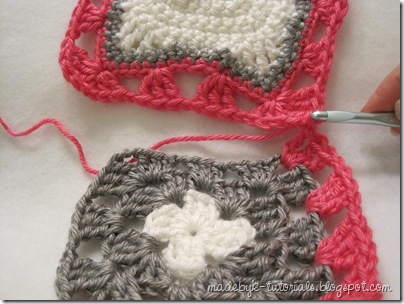
Start with background color yarn (pink), 6.00mm hook and a Granny Square Center:
Round 4: Insert hook into a (marked) 4th corner ch-2 sp, yo (with new color) and pull a loop through, ch3 (counts as dc), 2 dc in same sp, {ch1, DOUBLE} 3 times, ch 2, 3 tc in same sp, {ch 1, TRIPLE} 3 times, JSS, ch 1, 3 dc in same sp, {JSS, DOUBLE} 3 times, ch 1, JSS, 3 tc in same sp, {ch 1, TRIPLE} 3 times, ch2, sl st to top chain of beg ch-3. Bind off.
* * *
If your next square is a Hello Kitty with the joining edge at the bottom, i.e. under her chin, below are the directions for the last two rounds and joining as you go.
(photo coming soon)
Start with background color yarn (pink), 5.00mm hook and a Hello Kitty face:
R9: Turn/Hold face so marked ear is on the right if you’re right-handed, on the left if you’re left-handed. Starting at tip of ear, put hook through middle (marked) st of W in previous round, yo and pull loop through, ch 1, sc in same st, sc x 5, skip 1 st, sc x 2, skip 1 st, sc x 5, W, sc x 13, V, sc x 12, V, sc x 14 (14th sc is in same st as 1st sc of current round), sl st to 1st sc of current round —60 st.
(If you prefer to use conventional crochet pattern terminology, abbreviated version is here and full text is here.)
Switch to larger 6.00mm hook.
R10: Don’t turn. Ch 3 (counts as 1 dc st), 2 dc in sl st from previous round, ch1, TRIPLE, ch1, TRIPLE, ch1, DOUBLE, ch 2,
3 tc in same st, ch1, DOUBLE, ch1, DOUBLE, ch1, TRIPLE, JSS, ch1, 3 tc in same st, JSS, DOUBLE, JSS, DOUBLE, JSS, TRIPLE, ch1, JSS, 3 tc in same st, ch1, DOUBLE, ch1, DOUBLE, ch1, TRIPLE, ch2, sl st to top chain of beg ch-3; bind off —68 st.
* * *
And if your next square is a Hello Kitty with the joining edge at the top, i.e. above the ears, below are those directions.
(photo coming soon)
Start with background color yarn (pink), 5.00mm hook and a Hello Kitty face:
R9: Turn/Hold face so marked ear is on the right if you’re right-handed, on the left if you’re left-handed. Starting at tip of ear, put hook through middle (marked) st of W in previous round, yo and pull loop through, ch 1, sc in same st, sc x 5, skip 1 st, sc x 2, skip 1 st, sc x 5, W, sc x 13, V, sc x 12, V, sc x 14 (14th sc is in same st as 1st sc of current round), sl st to 1st sc of current round —60 st.
(If you prefer to use conventional crochet pattern terminology, abbreviated version is here and full text is here.)
Switch to larger 6.00mm hook.
R10: Don’t turn. Ch 3 (counts as 1 dc st), 2 dc in sl st from previous round, JSS, TRIPLE, JSS, TRIPLE, JSS, DOUBLE, ch1, JSS, 3 tc in same st, ch1, DOUBLE, ch1, DOUBLE, ch1, TRIPLE, ch2, 3 tc in same st, ch1, DOUBLE, ch1, DOUBLE, ch1, TRIPLE, ch2, 3 tc in same st, ch1, DOUBLE, ch1, DOUBLE, ch1, TRIPLE, JSS, ch1, sl st to top chain of beg ch-3; bind off —68 st.
Picot Border
With the squares all attached together, next step is to finish the edges and add some structure to the scarf by adding a border.
Notes: For the picot round, R3, you will be doing a series of {sc, sc, picot} sets except at the corners where there should be a picot in the stitch before the corner st, then 3 sc in the corner st, then a picot in the stitch after the corner st. So, depending on where you start along an edge, you may need to add a picot or a sc, picot before starting your first full set of {sc, sc, picot}. Also, if the number of stitches between the two corner stitches along an edge:
- is evenly divisible by 3, then add an extra sc into two of the {sc, sc picot} sets somewhere along the edge;
- has a remainder of 1, then no extra sc are needed;
- has a remainder of 2, add an extra sc into one of the {sc, sc, picot} sets.
* * *
Easy way (but I didn’t like how the border dipped in slightly at every spot where two squares joined):
Start with background color (pink), 6.00mm hook (I think, or maybe I used the 5.00mm one…) and joined squares:
R1: sc all the way around the scarf, doing 3 sc in each ch-2 sp corner, sl st to 1st sc of current round.
R2: ch 1, turn, sc all the way around the scarf, doing 3 sc at each corner, sl st to 1st sc of current round.
R3: ch 1, turn. Including the exceptions and additions as explained in picot note above, {sc, sc, picot} all the way around, doing 3 sc at each corner, sl st to 1st sc of current round
* * *
Slightly more complex way (that gives a smoother/straighter border because of the increased stitch heights at every spot where two squares join; see photo below)
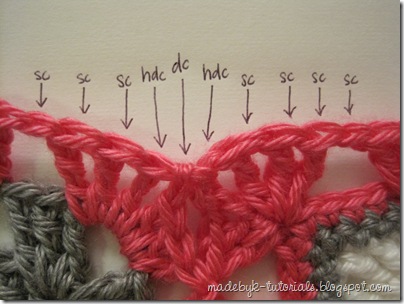
Start with background color (pink), 6.00mm hook (I think, or maybe I used the 5.00mm one…) and joined squares:
R1: Starting with 1 sc in the ch-2 sp at a corner heading toward a short edge, sc all along the short edge, 3 sc in the ch 2 corner space, 15 sc, {hdc, dc, hdc, 14 sc*}, repeat {} until you reach next corner, 3 sc in the ch 2 corner space, sc along the short edge, 3 sc in the ch 2 corner sp, 15 sc, {hdc, dc, hdc, 14 sc*}, repeat {} until you reach the corner, 1 sc in ch2 corner sp, sl st to 1st sc of current round.
*You might have to do fewer or more sc, depending on how you joined your squares.
R2: ch 1, turn, sc all the way around, doing 3 sc at each corner, sl st to 1st sc of current round.
R3: ch 1, turn. Adding extra sc if needed as explained in picot note above, {sc, sc, picot} all the way along, doing 3 sc at each corner, sl st to 1st sc of current round. Bind off.
Finishing
Weave in all ends and block the scarf. (If you’ve never blocked before, Rachel at crochetspot has some good info to get you started.) Then add the facial features and accessories and you’re done!
* * *
One of the keys to really making this look like Hello Kitty is correct placement of eyes, nose, and whiskers. Hopefully the gridlines on the image below are helpful. The eyes are really low, in the bottom half of her face, each about ¼ of the way in from the sides. And her nose is even lower, about ¼ of the way from the bottom edge.
![clip_image001[4] clip_image001[4]](http://lh6.ggpht.com/_HeAZI_Ym1xM/SxyHwlezCWI/AAAAAAAADfU/XK714KJQi8s/clip_image0014_thumb1.gif?imgmax=800)
So, using black yarn in a yarn needle, embroider eyes and whiskers. Embroider nose using yellow yarn.
In order to make a face on both sides, I made the eyes and nose by putting 3-4 stitches on top of each other, allowing two of the stitches to curve outward to create the oval shape and then tying each one off individually and trying to hide the knot under the stitches on the “back” side. For the whiskers, I did one long stitch for each, tied a knot on the “back” side, slid the knot as far to the outside as I could, i.e. off of her face, onto the outline, and then dabbed some FrayCheck/fabric glue onto the knot before cutting the tails off really short.
I will warn you – this was the hardest part for me and at least one other person: getting the eyes to be the same size and evenly aligned, getting the “back” to look at least half-way decent, hiding the knots on the back… I pulled out all my work and started over a number of times. But it is possible. I’ll take pictures of the next face I do.
* * *
Now for the flower for her ear…
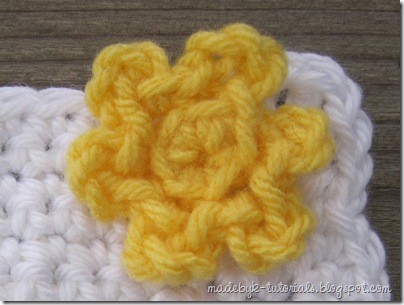
With flower color yarn (yellow):
R1: Start with magic ring (or alternate method: ch 4-6 and join into ring with sl st), ch 1 (does not count as st), 5 sc into magic ring (or plain chain ring), sl st to 1st sc (counts as a st).
R2: {sl st, ch 3, sl st} in BLO of each st. [6 petals].
After last sl st, cut yarn, pull through and tie to starting tail. Sew onto Hello Kitty face near right ear using white yarn so stitches don’t show on the other side. (For a one-sided application, I would have just used one of the yarn tails.)
* * *
I tried two bows and didn’t like either one. But they can’t be that hard to make. Any ideas? : )
Join As You Go
As mentioned earlier, this pattern joins the squares as they’re finished, not after the fact. Essentially, you substitute a slip stitch for a chain stitch along sides you want to join, inserting your hook into the corresponding chain space of another square before completing the slip stitch. For the scarf, always join along the longer edge of the square. The photos below show joining along the third edge; if you’re attaching a Hello Kitty square along its top edge, you will have to join right away along the first edge. In that case, do steps 6-16, then loop back to the beginning.
Here’s a photo tutorial of how I did that:
1. Finish last 3 tc shell of current edge. Match up current square to previous square.
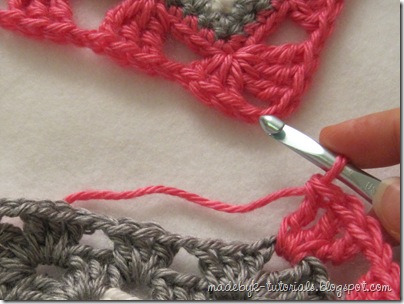
2. Insert hook, front to back, through ch 2 space at corner of previous square.
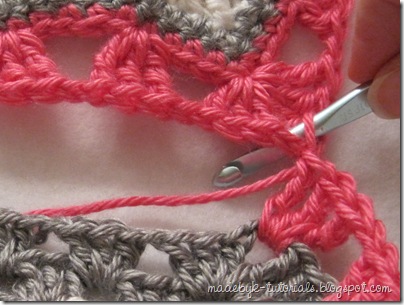
3. Yarn over…

4. …and pull loop through to create joining slip stitch.
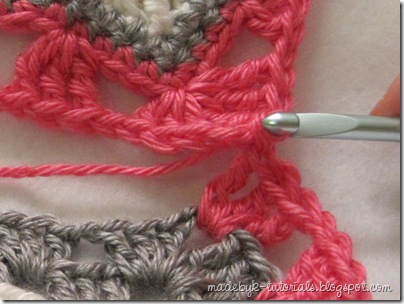
5. Chain 1 to finish corner (not shown in photos).
6. Crochet first dc shell of current edge.

7. Insert hook, front to back, through next ch 1 space on previous square.

8. Yarn over…
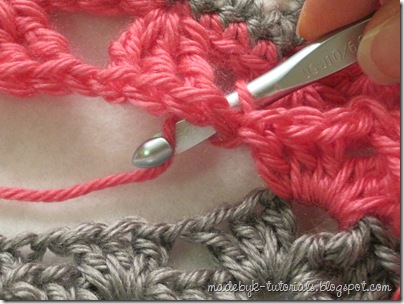
9. …and pull loop through to create joining slip stitch.
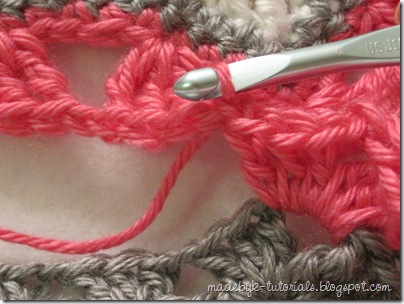
10. Crochet next dc shell.

11. Repeat 7-10 until you reach ch 2 space at next corner.
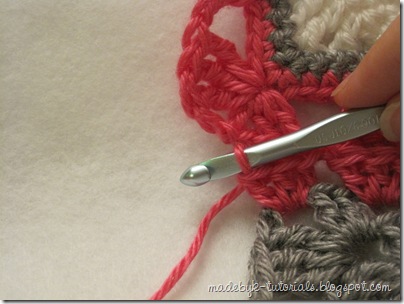
12. Chain 1 to finish edge/start corner (not shown in photos).
13. Insert hook, front to back, through ch 2 space at corner.
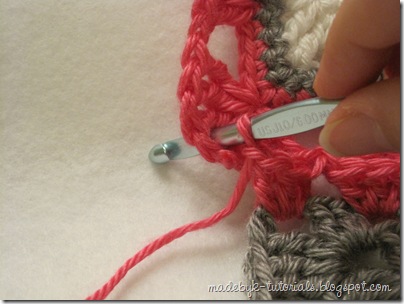
14. Yarn over…

15. …and pull loop through to create joining slip stitch.

16. Continue around remaining edges, starting with a
tc shell in the ch 2 corner space.
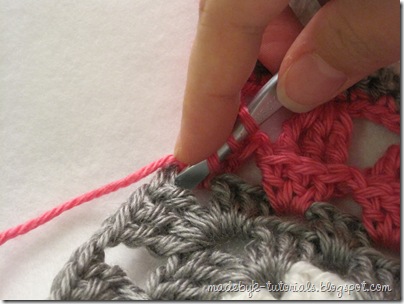
Finished Edge, joined as you went!

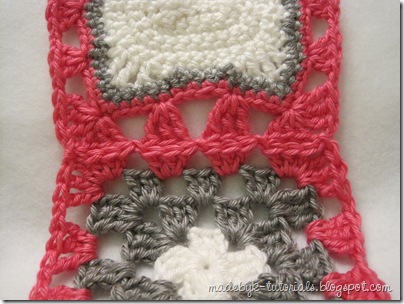
PDFs of pattern
If you want a shorter version to print out, here it is. Click the paper size you want to get to the downloadable pdf…
Hello Kitty Granny Square Scarf: Free Crochet Pattern
* US Letter size * A4 size *
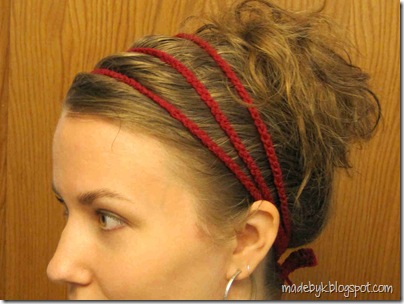
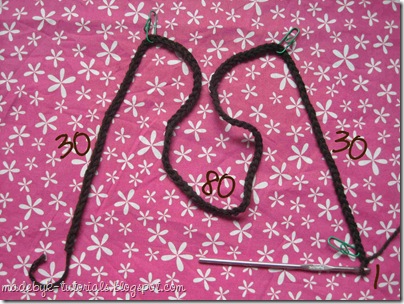
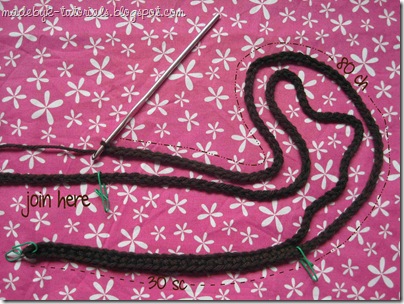
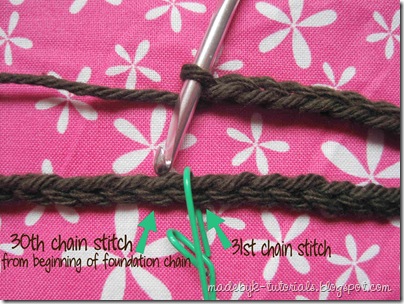
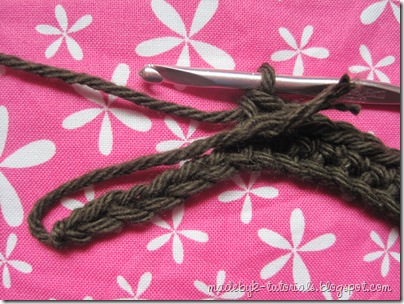
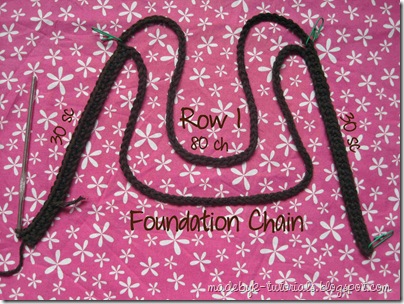
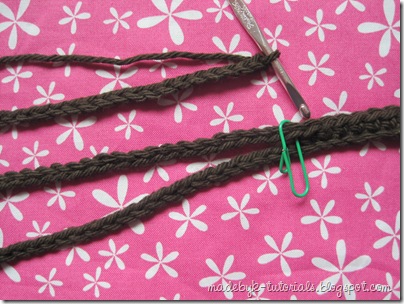

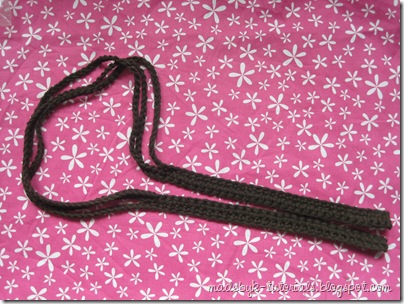











![clip_image001[4] clip_image001[4]](http://lh6.ggpht.com/_HeAZI_Ym1xM/SxyHwlezCWI/AAAAAAAADfU/XK714KJQi8s/clip_image0014_thumb1.gif?imgmax=800)
















